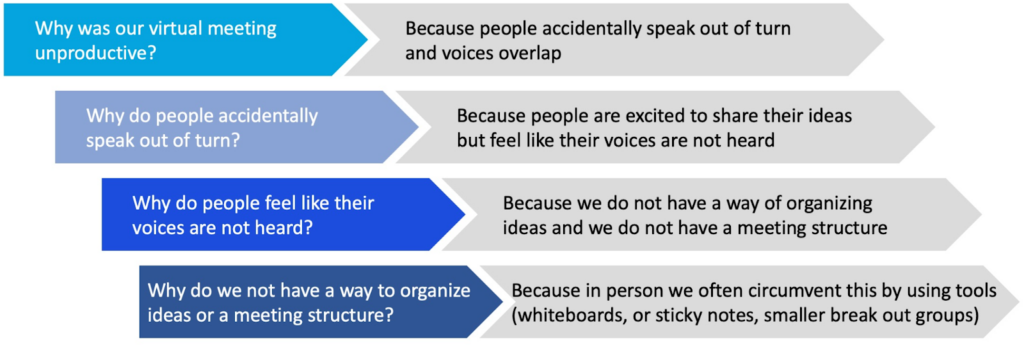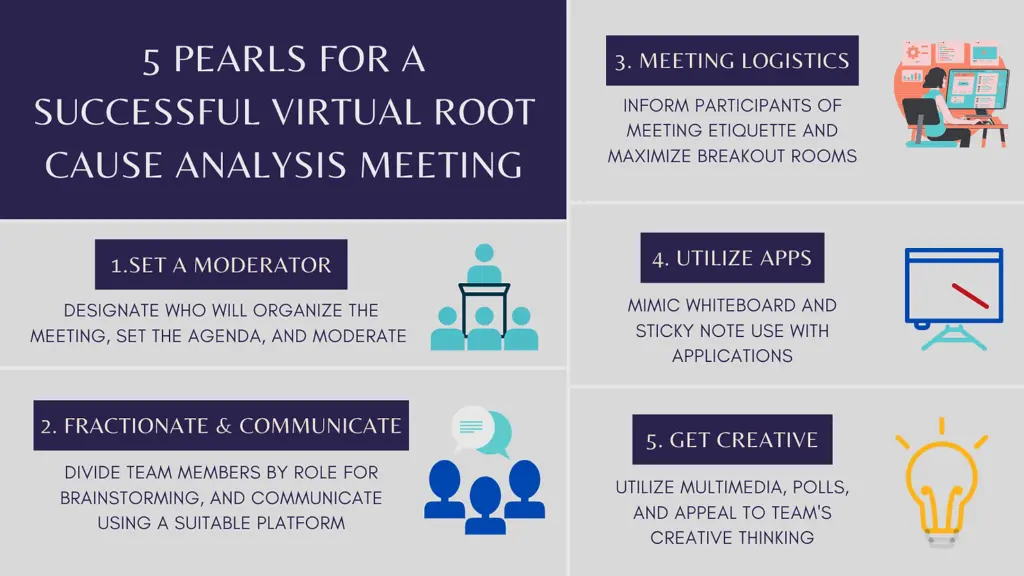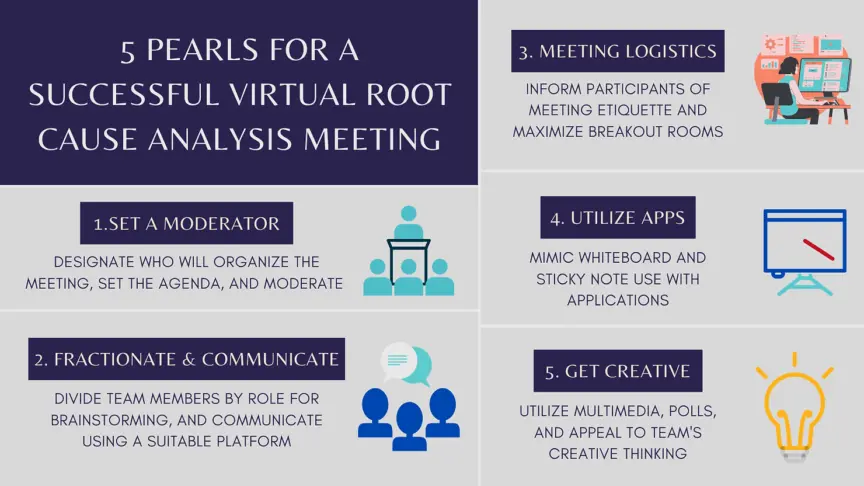You are midway through a busy rapid response shift where you have noticed an increased response time of the hospital’s intubating teams to decompensating patients. Over the last few months, the COVID-19 pandemic has prompted a restructuring of the use of many spaces to accommodate the influx of patients. You understand that the system is overwhelmed but you are optimistic that you can optimize the interprofessional team’s response times. This sets off a new QI project that you are excited about!
After some asynchronous work with the team, you decide on a project charter and pick an appropriate aim statement. You are now left with the root cause analysis (RCA) meeting where many stakeholders will be present to contribute ideas. But this RCA meeting will be held virtually – how do you go about this?!
Welcome back to another HiQuiPs post! During the pandemic, many of us have had to adapt our previously in-person meetings to virtual settings. It is no easy feat, especially when meetings such as for Root Cause Analysis (RCAs) require extensive real-time collaboration.
Reflecting on previous virtual meetings that didn’t go too well, you use the 5 whys mental exercise to think of contributory elements.

You may be used to RCA meetings with whiteboards, sticky notes or walk-arounds. With the ongoing need for a virtual approach, how do you best optimize them?
Currently, there is no literature on best practices for optimizing virtual collaboration, and specifically, when performing an RCA.
Here are some tips to get you started:
1. Set a Moderator
Having a person who leads the group by organizing team meetings, checking in with team members, moderating discussions, and setting the meeting agenda is crucial to ensure that a project continues to move forward. The moderator should ensure that they are able to use the online meeting tools effectively. They should also have the contact of the local IT person. If it is a very large meeting, it may be helpful to have an IT person on call/present, or an assigned attendee to take over muting/unmuting, breakout, and other functions.
2. Fractionate and Communicate
For virtual meetings, pre-meeting preparation becomes even more important to allow discussions to run smoothly. A period of asynchronous work may be completed prior to the meeting. You can consider organizing team members by their roles on the intubating team to discuss their workflows or other pre-assigned questions.
To host these pre-meeting discussions between groups of your team, a platform where the entire team and subgroups can communicate, share, and access files is useful. One example is Slack, through which your team can discuss details and share files within the overarching Team “channel” and in their own group’s “channel” chat. Other applications with similar features are Google Chat or the Microsoft Teams chat function. The platforms differ in scalability and some offer paid options depending on your team’s needs. A brief introduction on how to use the chosen communication platform should be sent to the participants in case they are not familiar with it.
3. Meeting Logistics
For the first team meeting, outlining a quick review of the meeting tool utilization and meeting etiquette may be beneficial. Will you be using raising hand functions, the tool chat, sharing screens, group voting, etc.? Are participants encouraged to keep their video on and their microphones off? Letting your participants know what to expect may reduce confusion later on.
There is also a ’break-out’ room function with services such as Zoom or Microsoft Teams. This way, meeting structure can be maintained and may enable concurrent interprofessional or role-based discussions. When the breakout time ends, all meeting members are sent back to the main meeting where the designated spokespeople can present their group’s thoughts. Please see the hyperlinks for tutorials on creating breakout rooms for Zoom and Microsoft Teams.
4. Utilizing Apps to Support Engagement
One function that can be missing during virtual RCA meetings compared to in-person is the whiteboard/sticky notes that some find helpful for creating Fishbone diagrams and for process mapping. Miro is an online whiteboard built for collaboration. With Miro, team members can video chat while using the whiteboard space to directly share images, videos, and documents and utilize virtual sticky notes and chart templates. Available templates include 5 Whys, Fishbone diagram, Concept maps, and other tools such as a Stakeholder Analysis template. Miro can also be integrated with other apps such as Microsoft Teams and Slack.
Another virtual whiteboard application is Google Jamboard. Google Jamboard works similarly to Miro where users can collaborate to share content and collaborate using virtual sticky notes. Google Jamboard does not contain templates like Miro, but Google Jamboard does have free drawing functions with pens and shapes, allowing users to more freely create their own charts and maps. Miro and Google Jamboard differ in scale and pricing depending on the organization’s needs.
5. Get Creative
While there are more online apps to support RCA group work, if they are not for you and you want a ‘low tech’ way of doing sticky notes and other types of brainstorming (for smaller groups) consider sharing your computer screen and working off of Microsoft PowerPoint or other similar tools.
Get creative and engage your team members! An engaging virtual meeting is still possible. You have cut down on didactic work by doing asynchronous pre-work. Now you can seamlessly share multimedia, create polls, and engage in lively debate and discussion. You can also take group pictures and share them on social media!

Summary
Now that you are equipped with these pearls in your back pocket, you decide on several key questions for groups to answer on Slack pre-meeting. You also have a Google Doc to share all of your group documents integrated with Slack. The meeting starts off with some introductions and smoothly goes between breakout session discussions and polls while you use Miro for brainstorming. Your team creates a great Fishbone and Driver diagram highlighting key areas of intervention for your next meeting!
*The applications mentioned are for illustrative purposes. The authors have no conflicts of interest to declare.
Senior editors: Dr. Lucas Chartier, Dr. Ahmed Taher
This post was copyedited by Noaah Reaume, Tiffany Tse, and Yoyo Chen.




